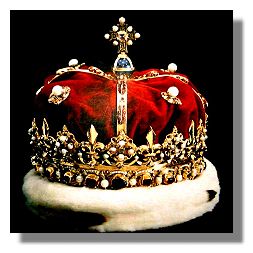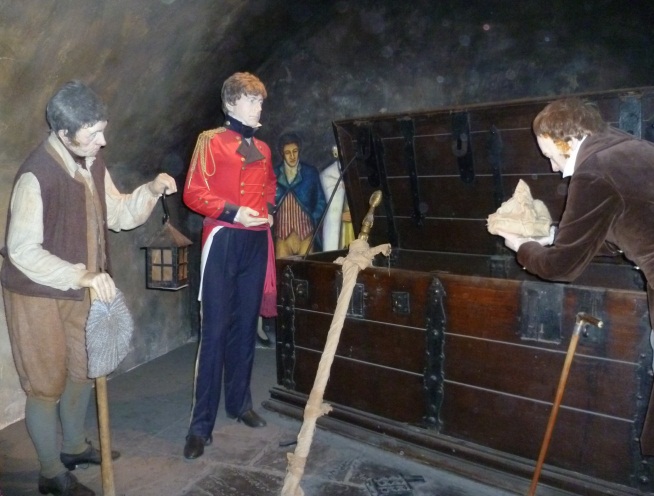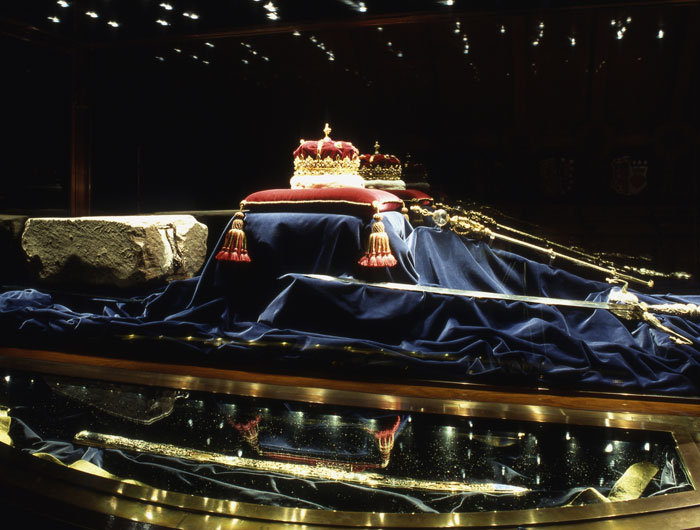 |
The
Crown of Scotland in its present form dates from
1540 when James V ordered the Edinburgh
goldsmith John Mosman to refashion the original
crown. James wore it to his consort's coronation
in the same year at the abbey church of Holyrood.
The circlet at the base is made from Scottish
gold and is encrusted with 22 gemstones and 20
precious stones taken from the previous crown.
Freshwater pearls from Scotland's rivers were
also used. The crown weighs 3 lbs. 10 oz. The
crown was remodeled in 1540 for James V when the
velvet and ermine bonnet were added to bring it
to its present form. It is not known exactly
when the crown was originally made, but it can
be seen in its pre-1540 form in the famous
portrait of James IV of Scotland in the Book of
Hours that was created for his marriage to
Margaret Tudor in 1503. |
The four
golden arches of the Crown are ornamented with gold and
red enameled oak leaves, apparently of French
workmanship. At the point where the arches meet there
rests an orb of gold which is enameled in blue and
ornamented with gilt stars. This is surmounted by a
large cross decorated in gold and black enamel with an
amethyst in rectangular form, in the center. The upper
and two side extremities of the cross are adorned with
pearls.
The Scepter
was a gift from Pope Alexander VI to King James IV in
1494, and was remodeled and lengthened in 1536. It is
made of silver gilt, and is topped by a finial with
polished rock (possibly Cairngorm) and a Scottish pearl.
The Scepter includes several Christian symbols: stylized
dolphins, symbols of the Church, appear on the head of
the rod, as do images of the Virgin Mary holding a baby
Christ, of Saint James the Great, and of Saint Andrew
holding a saltire.
The Sword of
State of Scotland was also a papal gift; Pope Julius II
presented it to James IV in 1507 (see insert). The
etched blade, measuring 4.5 feet in length, includes
figures of Saint Peter and Saint Paul, as well as the
etched name of Julius II. The silver gilt handle bears
figures of oak leaves and acorns. The sword, an example
of Italian craftsmanship, was damaged in 1652 whilst
being hidden from Cromwell's troops, as it had to be
broken in half in order to be properly concealed while
it was being taken to safety. It is accompanied by a
wooden scabbard which is covered with velvet and silver
and hung from a woven silk and thread of gold belt.
The Honours
as coronation regalia were first used together at the
coronation of the nine-month-old Mary, Queen of Scots in
1543, and subsequently at the coronations of her infant
son James VI (and I of England) at Stirling in 1567 and
her grandson Charles I in 1633 at the Palace of
Holyroodhouse.
Despite his
success at the Battle of Dunbar in 1650 and his
subsequent occupation of Edinburgh Castle, Oliver
Cromwell failed to stop the coronation of Charles II in
1651 at Scone (the last coronation in Scotland).
Determined
to destroy the Scottish Crown Jewels, just as he had
disposed of the English regalia, Cromwell pursued the
Honours to Dunnottar Castle near Aberdeen. He failed.
From there, they were smuggled out for safe burial until
Charles II's restoration in 1660.
The Honours
were never again used to crown a sovereign. Until the
Treaty of Union in 1707, and in the absence of a
resident monarch, the regalia were taken to sittings of
the Parliament in Edinburgh to signify the Sovereign's
presence and his or her consent to the passing of each
Act.
After the
Union, when the new United Kingdom Parliament met in
London, the Honours had no ceremonial role. They were
locked away in an oak chest in the Crown Room at
Edinburgh Castle.

In 1818, the
chest was opened in the presence of the Castle Governor
and the author Walter Scott. They discovered the Honours
were still there in their linen wrappings.
During the
Second World War the Honours were hidden once again.
They were buried in 1941 at separate locations in the
Castle as a precaution against possible German invasion.
The Honours
were removed once from the Castle in 1953, to be taken
to a National Service of Thanksgiving at the High Kirk
of St Giles in Edinburgh. During the ceremony they were
formally presented to The Queen, who then returned them
to their custodians.

Since 1819,
the Honours have been on public display in the Crown
Room at Edinburgh Castle, together with the Stewart and
the Lorne Jewels. The Stone of Scone was added in 1996,
after 700 years in Westminster Abbey. The last time the
Honours of Scotland were used for a coronation was to
crown Charles II at Scone in 1651.
In May 1999,
at the first sitting of the devolved Scottish
Parliament, in October 2004 at the opening of the new
Scottish Parliament Building, and at subsequent opening
ceremonies of each new Session of the Scottish
Parliament the Crown of Scotland has been present
alongside the Monarch. Due to their age and condition
the Sword and the Scepter are considered too delicate to
be present alongside the Crown at such occasions.

